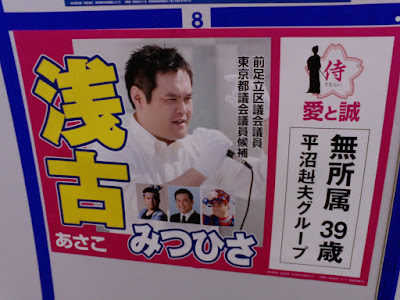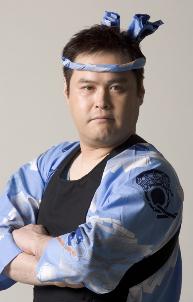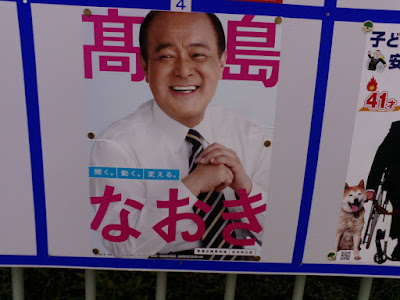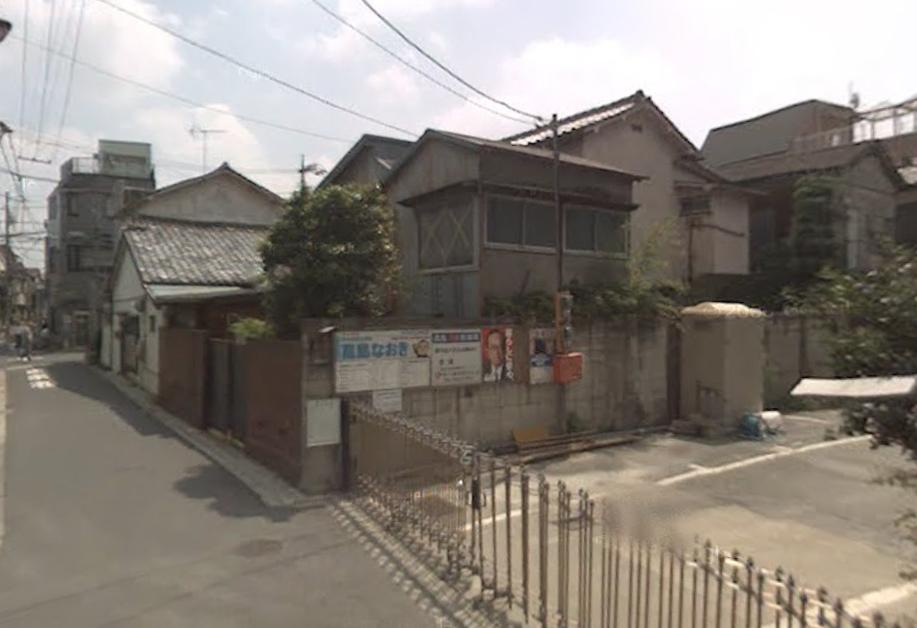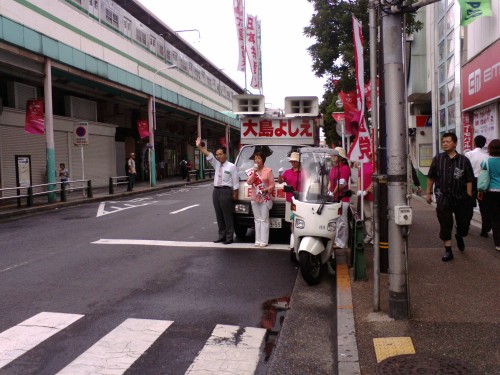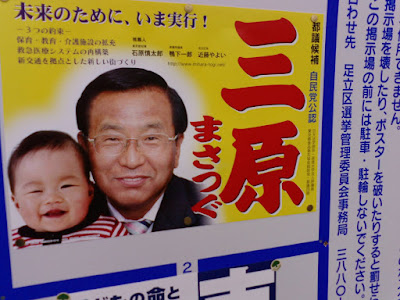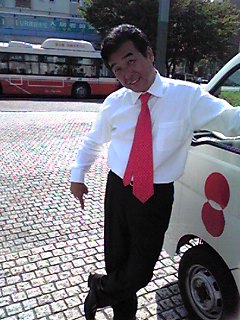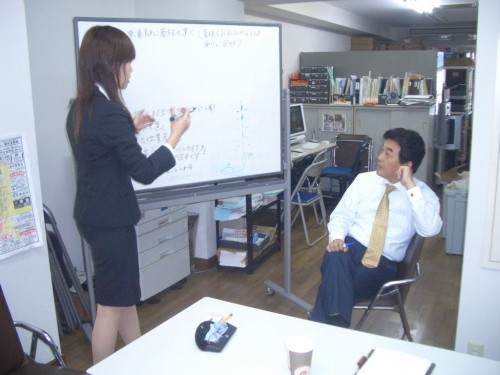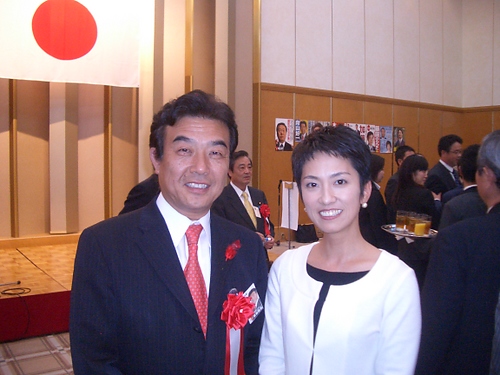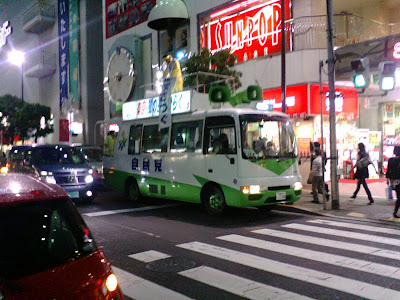On July 12 the Tokyo Legislative Assembly elections will be held. While the TLA does not appear to do much in the grand scheme of things, this election is personally important to me as it will mark my first experience with an election where Mrs. Adamu can actually cast a ballot (in previous elections she could not vote for one reason or another). With that in mind and in the interest of being an informed voter’s spouse, I decided to take a look at what this is all about with a focus on Adachi-ku, the ku I call home.
How is the assembly chosen?
With 127 members (one representing roughly 100,000 people), Tokyo’s legislature is the nation’s biggest local assembly of any kind. Members come from 43 mostly multi-member districts and are elected all at once to four-year terms using the single non-transferable vote system similar to the Lower House elections prior to 1994. For example, in Adachi-ku’s case, voters choose an individual and the top six vote-getters win seats. The 42 districts consist of the 23 cities or “ku,” 18 cities within the prefectural boundaries, and one to cover all the outlying islands. Adachi-ku, where I live, is allotted six seats.
Most local elections in Japan are held all at once every four years in what are called the “unified local elections” (統一地方選) (the last round was in 2007), but Tokyo’s are held two years after that. They used to sync with the rest of the country, but the schedule got screwed up in 1965 when an LDP bribery scandal spurred leftist parties to push for a recall, leading to a voluntary dissolution and early election.
Currently, the LDP-New Komeito coalition maintains an overwhelming majority of seats (with a respective 48 and 22 members each), followed by the DPJ with 22 members, 13 Communists, and single-digit membership from the left-leaning Tokyo Seikatsusha Network and unaffiliated politicians.
What do they do?
In typical assembly fashion, they are responsible for passing local ordinances (条例) and approving the prefecture’s budget, which at 6 trillion yen just for the general account is on par with Finland’s GDP.
The prefectural assembly’s other enumerated powers according to the Tokyo Prefectural Assembly website include investigating and auditing the executive branch, passing a no-confidence motion against the governor, and responding to requests from Tokyo residents to investigate various grievances.
What are some of their more recent achievements? How powerful are they?
Since Tokyo’s government is set up somewhat similarly to a US state (unicameral legislature and a fairly powerful directly elected governor), the assembly can wield significant power if the party/coalition holding a majority of seats is opposed to the governor’s agenda. However, this is not currently the case, so right now they don’t do much.
News outlets openly report that the assembly is all but a rubber stamp for the executive, owing to a comfortable relationship with recent cozy LDP-Komeito majorities (and occasional DPJ cooperation) and three consecutive terms for Governor Shintaro Ishihara, who is not officially backed by any party but has an ideological affiliation with the LDP-Komeito as one of Japan’s leading conservatives. Prefectural assembly meetings are perfunctory affairs in which the elected members simply read from a script which has been prepared in advance by bureaucrats from the governor’s office, a process euphemistically called nemawashi i.e. backroom dealing. The Communists and other leftist parties do their best to stir up scandal (Ishihara’s lavish trips abroad and the catastrophic small-business bank among them), but voters keep voting in this conservative bloc.
Most of the assembly’s routine agenda appears to be fairly mundane, except when they are called on to give their blessing to the pet projects of either Governor Ishihara or the national government. A look at the agenda of assembly meetings in 2009 shows such typical local administration as minor revisions to health service fees, approval of staff rosters for the fire departments, and the establishment of a new police precinct. However, it is unclear how much room for originality the prefecture has when they must contend with the agendas of the Tokyo prefectural bureaucracy (firmly controlled by Governor Ishihara) and the prerogatives of the internal affairs ministry.
In May, the prefecture passed an emergency supplementary budget to provide economic stimulus in coordination with the central government’s efforts. They approved spending of 134.9 billion yen (with about half the funding from the central government, with the rest paid for by revenues from prefectural revenues and a bond issue). The money went to beef up a consumer protection agency, subsidize day-care centers, pay additional outlays to pregnant women, fund high-tech education, and more.
A 2007 report from citizen journalism site JANJAN decried the governor’s strong influence over the prefectural government, owing not only to the majority LDP-New Komeito who form a loyal right-wing support base thanks to their alliance in national politics, but also to a compliant DPJ. For example, the legislature is in charge of regulations/zoning of prefecture-run wholesale markets, and this includes the world-famous Tsukiji fish market. A decision made in 2001 to move the market to Toyosu, where more modern facilities can be constructed, met with opposition at the last minute due to claims of pollution at the new site in Toyosu. However, the assembly members were not hearing it and the move remains on schedule for 2012.
In another example of Ishihara’s absolute control over his pet projects, the Tokyo legislature gained national attention recently for approving multiple bailouts of New Bank Tokyo (新銀行東京). This bank was created as the fulfillment of Ishihara’s campaign promise to start a bank for small Tokyo-based companies during a bid for reelection in 2002. After opening for business in 2004, just three years later the bank became insolvent due to notoriously lax lending standards that led to enormous losses from the very beginning. But despite this embarrassing failure, the Tokyo assembly was unwilling to refuse Ishihara’s insistence on providing the bank with 4 billion yen in new capital and a new lease on life. In this instance the DPJ members opposed the bailout but it passed with LDP and Komeito support.
The media outlets reporting these scandals seemed genuinely frustrated with the assembly for these recent scandals, but it seems like they should save their breath for the governor’s office, because once Ishihara has made up his mind the TLA won’t do much to stop him.
Other so-called “third sector” businesses directly run by Tokyo Prefecture include the “Toei” subway lines and buses and prefectural government housing.
What are the issues in this election?
There are none. If you have heard anything about this upcoming election, it is probably that a poor showing by the LDP could spell trouble for Prime Minister Aso’s government and could trigger an early election (latest reports are that Aso might just dissolve the Lower House before the prefectural elections. Not even the Tokyo Shimbun could identify an angle outside of whether the LDP-Komeito coalition can hold onto power. I’ll go into more detail on the candidates themselves later, but their pledges tend to focus on populist rhetoric like helping small businesses, cutting income taxes, and lowering medical fees.
Otherwise, interest in the election is fairly low (but higher than a typical US election). The last election in July 2005 boasted a mere 43.99% turnout, which falls somewhere among the typical turnout of 40-50%.
***
OK, that’s enough for now. Next time I will try and profile the candidates in the election and see if it makes a difference.
